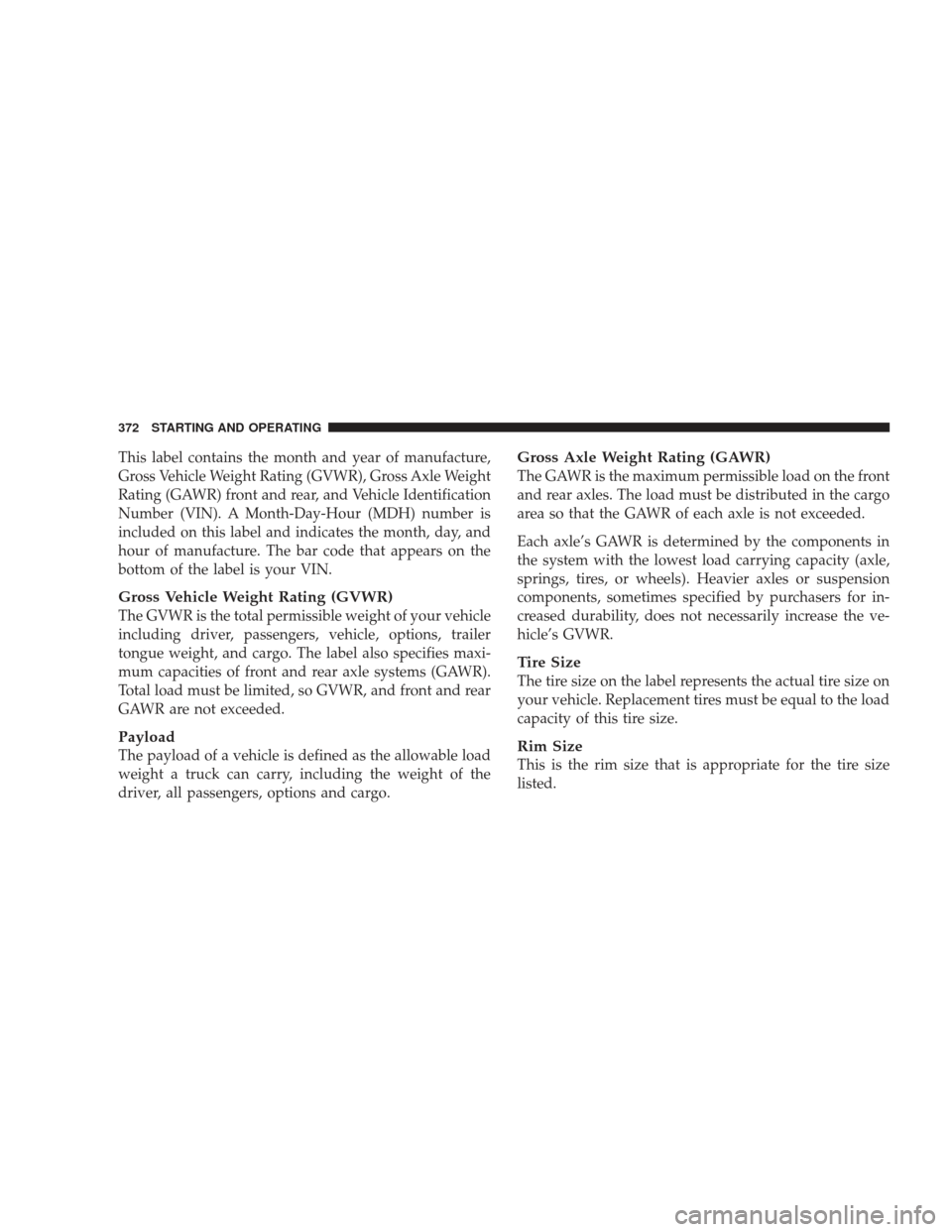Page 363 of 506

Telltale Light will turn off, as long as no tire pressure is
below the low-pressure warning limit in any of the four
active road tires. The vehicle may need to be driven for
up to 20 minutes above 15 mph (25 km/h) in order for the
TPMS to receive this information.
Premium System — If Equipped
The Tire Pressure Monitor System (TPMS) uses wireless
technology with wheel rim mounted electronic sensors to
monitor tire pressure levels. Sensors, mounted to each
wheel as part of the valve stem, transmit tire pressure
readings to the receiver module.
NOTE:It is particularly important for you to check the
tire pressure in all of the tires on your vehicle monthly
and to maintain the proper pressure.
The TPMS consists of the following components:
•Receiver Module
•Four Tire Pressure Monitoring Sensors
•Three Trigger Modules (mounted in three of the four
wheel-wells)
•Various Tire Pressure Monitoring System messages,
which display in the Electronic Vehicle Information
Center (EVIC)
•Tire Pressure Monitoring Telltale Light
The matching full size spare wheel and tire assembly (if
equipped) has a tire pressure monitoring sensor. The full
size spare can be used in place of any of the four road
tires. A spare with a pressure below the low-pressure
limit will not cause the Tire Pressure Monitoring Telltale
Light to illuminate or the chime to sound. However, it
will cause a “SPARE LOW PRESSURE” message to
display in the EVIC.
STARTING AND OPERATING 361
5
Page 365 of 506

If the ignition key is cycled, this sequence will repeat,
providing the system fault still exists. If the system fault
no longer exists, the Tire Pressure Monitoring Telltale
Light will no longer flash, and the�CHECK TPM SYS-
TEM� message will no longer display, and a pressure
value will display in place of the dashes. A system fault
can occur due to any of the following: 1. Jamming due to electronic devices or driving next to
facilities emitting the same radio frequencies as the TPMS
sensors.
2. Installing some form of aftermarket window tinting
that affects radio wave signals.
3. Lots of snow or ice around the wheels or wheel
housings.
4. Using tire chains on the vehicle.
5. Using wheels/tires not equipped with TPMS sensors.
Vehicles with Full-Size Spare
1. The matching full size spare wheel and tire assembly
has a tire pressure monitoring sensor that can be moni-
tored by the TPMS.
2. If you install the full size spare in place of a road tire
that has a pressure below the low-pressure warning limit,
a chime will sound and the TPMS Telltale Light will turn
STARTING AND OPERATING 363
5
Page 374 of 506

This label contains the month and year of manufacture,
Gross Vehicle Weight Rating (GVWR), Gross Axle Weight
Rating (GAWR) front and rear, and Vehicle Identification
Number (VIN). A Month-Day-Hour (MDH) number is
included on this label and indicates the month, day, and
hour of manufacture. The bar code that appears on the
bottom of the label is your VIN.
Gross Vehicle Weight Rating (GVWR)
The GVWR is the total permissible weight of your vehicle
including driver, passengers, vehicle, options, trailer
tongue weight, and cargo. The label also specifies maxi-
mum capacities of front and rear axle systems (GAWR).
Total load must be limited, so GVWR, and front and rear
GAWR are not exceeded.
Payload
The payload of a vehicle is defined as the allowable load
weight a truck can carry, including the weight of the
driver, all passengers, options and cargo.
Gross Axle Weight Rating (GAWR)
The GAWR is the maximum permissible load on the front
and rear axles. The load must be distributed in the cargo
area so that the GAWR of each axle is not exceeded.
Each axle’s GAWR is determined by the components in
the system with the lowest load carrying capacity (axle,
springs, tires, or wheels). Heavier axles or suspension
components, sometimes specified by purchasers for in-
creased durability, does not necessarily increase the ve-
hicle’s GVWR.
Tire Size
The tire size on the label represents the actual tire size on
your vehicle. Replacement tires must be equal to the load
capacity of this tire size.
Rim Size
This is the rim size that is appropriate for the tire size
listed.
372 STARTING AND OPERATING
Page 500 of 506

Theft Alarm (Security Alarm)................ 18
Theft System (Security Alarm) ............... 18
Tie Down Hooks, Cargo ................... 188
Tilt Steering Column ..................... 154
Time Delay, Headlight .................... 144
Tip Start .............................. 291
Tire and Loading Information Placard ......... 342
Tire Identification Number (TIN) ............. 341
Tire Markings .......................... 337
Tire Safety Information .................... 337
Tires ............................ 83,346,476
Air Pressure .......................... 347
Chains .............................. 353
Changing ............................ 395
Compact Spare ........................ 350
General Information .................... 346
High Speed .......................... 349
Inflation Pressures ..................... 347
Jacking ............................. 395 Life of Tires
.......................... 352
Load Capacity ........................ 342
Pressure Monitor System (TPMS) ........... 356
Pressure Warning Light .................. 202
Quality Grading ....................... 476
Radial .............................. 349
Replacement ......................... 352
Rotation ............................ 355
Safety .............................. 337
Sizes ............................... 339
Spare Tire ........................... 396
Spinning ............................ 351
Tread Wear Indicators ................... 351
To Open Hood .......................... 140
Tongue Weight/Trailer Weight .............. 382
Torque Converter Clutch .................. 301
Tow/Haul Indicator Light ................. 207
Towing ............................... 374
24-Hour Towing Assistance ............... 108
498 INDEX
Page:
< prev 1-8 9-16 17-24